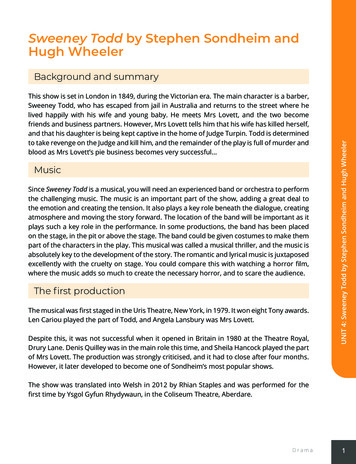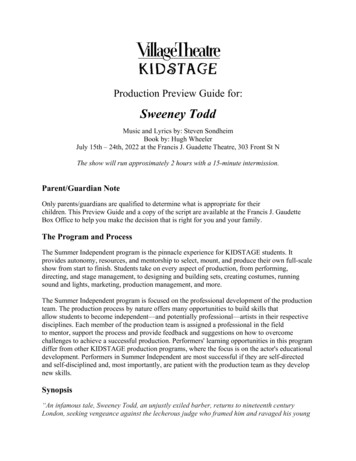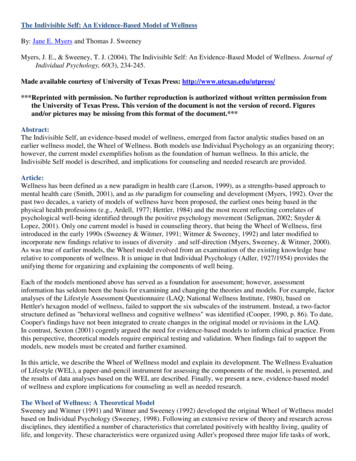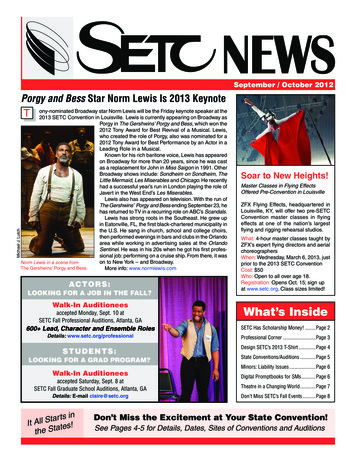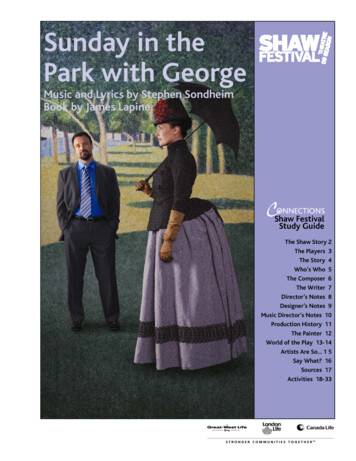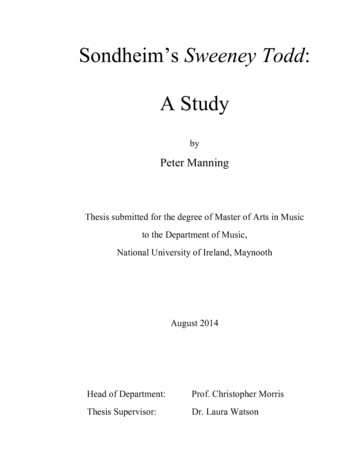
Transcription
Sondheim’s Sweeney Todd:A StudybyPeter ManningThesis submitted for the degree of Master of Arts in Musicto the Department of Music,National University of Ireland, MaynoothAugust 2014Head of Department:Prof. Christopher MorrisThesis Supervisor:Dr. Laura Watson
CONTENTSAcknowledgementsiiiList of Music ExamplesivPreface1Chapter 15Chapter 215Chapter 327Conclusion49Appendix A51Appendix B58Bibliography60Abstract62ii
ACKNOWLEDGEMENTSI would like to thank my supervisor, Dr. Laura Watson, for all of her help in structuring thisthesis.I would also like to thank my parents, Ray and Mary, for offering their time to proofreadthis thesis, and for being a constant source of love and encouragement. To them, I dedicatethis work.iii
LIST OF MUSIC EXAMPLESNote: All music examples are taken from the published vocal score of Sweeney Todd[Sondheim, Stephen, Sweeney Todd: The Demon Barber of Fleet Street (WI: Hal Leonard,2010)]Example 1: ‘God, That’s Good!,’ b. 70-73Example 2: ‘Johanna (Judge Turpin),’ b. 1-1aExample 3: ‘The Judge’s Return,’ b. 66-71Example 4: Dies Irae chant in modern notationExample 5: ‘Prelude,’ b. 26-29Example 6: ‘The Ballad of Sweeney Todd,’ b. 5-6Example 7: ‘The Ballad of Sweeney Todd,’ b. 59-74Example 8: ‘My Friends,’ b. 3-6Example 9: ‘Prelude,’ b. 1Example 10: ‘Epiphany,’ b. 41-44Example 11: ‘No Place Like London,’ b. 202-204Example 12: ‘My Friends,’ b. 3-14Example 13: ‘Epiphany,’ b. 50-64Example 14: ‘Epiphany,’ b. 71-80Example 15: ‘The Worst Pies in London,’ b. 39-50Example 16: ‘Wait,’ b. 68-74Example 17: ‘No Place Like London,’ b. 256-257Example 18: ‘Epiphany,’ b. 1-3Example 19: ‘God, That’s Good!,’ b. 92-93Example 20: ‘Pirelli Death Underscore,’ b. 72iv
Example 21: ‘The Worst Pies in London,’ b. 2Example 22: ‘The Worst Pies in London,’ b. 39Example 23: ‘A Little Priest,’ b. 21-24Example 24: ‘By the Sea’ b. 2-3Example 25: ‘Prelude,’ b. 1-4Example 26: ‘No Place Like London,’ b. 28-29Example 27: ‘Epiphany,’ b. 71-73Example 28: ‘Final Scene (Part I),’ b. BExample 29: ‘Final Scene (Part I),’ b. 5v
PREFACEStephen Sondheim: An IntroductionStephen Sondheim (b. 1930) has been the most influential and important composing figurein musical theatre since the latter half of the twentieth century. A mentee of OscarHammerstein II, Sondheim began his Broadway career working as a frustrated lyricist forWest Side Story (1957) and Gypsy (1959), before finally tackling both music and lyrics forhis own series of titles beginning with A Funny Thing Happened on the Way to the Forum(1962) and Anyone Can Whistle (1964). It wasn’t until 1970, however, with Company, thatSondheim was hailed for the first time as the new innovator of the American musicaltheatre. A string of controversial shows followed which included Follies (1971), A LittleNight Music (1972), Pacific Overtures (1976), Sweeney Todd, the Demon Barber of FleetStreet (1979), Merrily We Roll Along (1981), Sunday in the Park with George (1984), Intothe Woods (1987), Assassins (1990), and Passion (1994).Before the Sondheim era, musicals were seen as being light, frivolous forms ofentertainment for middle class families. Even when some of these earlier shows attemptedto deal with heavier themes and concepts, their endings were ultimately happy and left theiraudiences smiling. This conventional romantic ideology associated with the form wascompletely rejected by Sondheim beginning with Company, who, with his collaborators,chose to stimulate the minds of his audiences, placing relatable characters with real-lifeproblems on the musical stage.No two works of Sondheim’s are similar in style or presentation, in spite of thegeneral over-arching controversy attached to his canon. In general, most of his works fall1
under the ‘concept musical’ idea, i.e. where music, text, dance, dialogue, design anddirection all merge together to create a central theme or metaphor, and where a linearnarrative plot is perhaps not deemed as important. While some of Sondheim’s musicals dealwith linear plots more crucially than others, this is the general idea used for his catalogue.In spite of the acclaim received by Sondheim and his collaborators, the composer still facescriticism to this day, as it appears that audiences constantly find it difficult to connect withsuch heavy material in the confines of a Broadway musical. His music is at timesunconventional, often merging complex rhythms with contrapuntal melodies, married withthought-provoking, complicated lyrics that root the characters depicted on stage in a realityand humanity, something that was practically unheard of in a musical. In this way,Sondheim truly is the most important figure in musical theatre of our time.Aims of studyThis thesis focuses on Sondheim’s 1979 work, Sweeney Todd, the Demon Barber of FleetStreet (referred to simply as Sweeney Todd from now on), and serves as a brief study of thepiece, examining its musical and dramatic significance. Sondheim’s score for Sweeney isone of his richest and most complicated, while the subject matter provides its own weightas an unusual plot for a Broadway musical. Rather than focusing on any one particularfeature of the work, the thesis delves into various aspects of music, text, and character, andbrings to light some of Sondheim’s most innovative compositional and textual devices. Thecontroversial plot, rich book and stylistically interdependent almost sung-through scoregives the work a unique quality that separates it from the other titles in Sondheim’s canon,and overall, from other works in the broader musical theatre catalogue.2
Sondheim’s appreciation in academia by both musicologists and theatre scholars hastaken quite some time to develop because of the apparent stigma attached to the form. Thisdissertation ultimately responds to both the attention and the neglect given to this composerin the world of musicology.Literature ReviewIn my studies, I have been aided by publications on Sondheim, both from a musical andtheatrical point of view. Some of the titles that I found particularly helpful and insightfulwere Stephen Banfield’s Sondheim’s Broadway Musicals, which analyses the structuralprocesses of the scores of Sondheim’s musicals; Mark Horowitz’s Sondheim on Music,which transcribes a series of recorded interviews with the composer about hiscompositional methods; and Geoffrey Block’s Enchanted Evenings, which examines thedevelopment of the Broadway musical as we know it.The material in these books assists my research in different ways. In some cases, itsupports my arguments; in other cases, it gives way to the creation of new ideas. Theaforementioned three books discuss the composer’s music in detail, whereas Sondheim’sown two personal books, Finishing the Hat and Look, I Made A Hat, discuss the lyrics ofhis songs in detail. In Stephen Sondheim: A Casebook (edited by Joanne Gordon), andReading Stephen Sondheim (edited by Sandor Goodhart), no music is discussed. The essaysfound in these books simply analyse various literary themes and concepts found in theSondheim catalogue.3
Chapter Outline and MethodologyChapter 1 of this thesis introduces Sweeney Todd to the reader. A discussion of theorigins of the character as an urban legend leads to an examination of Christopher Bond’s1973 stage adaptation of the story, and eventually, a consideration of Stephen Sondheimand Hugh Wheeler’s musical adaptation of that particular version. The chapter introducesthe musical, by discussing some of the key themes and literary concepts found in the work.Historical and textual analysis is employed here.Chapter 2 introduces the music of Sweeney Todd, and analyses the film influencesfound in the score, and the interesting use of the Dies Irae theme. The question of genre isalso addressed. Music analysis is used here.Chapter 3 analyses the characters of Sweeney Todd and Mrs. Lovett as well as thechorus, musically and textually, and examines Sondheim’s use of leitmotif work in thescore. Once again, music analysis is employed here.The appendix provides a detailed synopsis of the show, as well as a list of musicalnumbers.4
CHAPTER 1Origins of Sweeney ToddThe British urban legend of serial killer Sweeney Todd, in basic terms, is the story of theDemon Barber of Fleet Street (London), who slits the throats of his innocent customers,and dispatches their corpses by sending them down a chute below his parlour, where, inlater versions of the tale, the character of Mrs. Lovett assists in the disposing of the bodiesby baking their remains into meat pies and selling them in her shop. The character ofSweeney Todd had been navigating the pages of serials, storybooks, and the confines oftheatre and television, long before Stephen Sondheim ever put pen to paper. In fact, thelegend of the Demon Barber has been intriguing audiences since the mid-nineteenthcentury. Although traces of its origins are difficult to establish—the story has been linkedto a fourteenth century French ballad, a seventeenth century Scottish legend, and aneighteenth century Fleet Street court case1—one thing for certain is that the first time thecharacter appeared in his fully-fledged form was in Thomas Peckett Prest’s penny dreadful(or serial) The String of Pearls in 1846, having previously been mentioned fleetingly byCharles Dickens in Martin Chuzzlewit (1843-4).2 George Dibdin Pitt adapted Prest’s storyfor the stage as a melodrama in 1847,3 while more recent adaptations have appeared innovel-form in 2007 by Robert L. Mack and, briefly, in 2012 in Terry Pratchett’s Dodger.41Robert Kimball, ‘Sweeney Todd,’ in Stephen Sondheim and Hugh Wheeler, Sweeney Todd: The DemonBarber of Fleet Street (London: Nick Hern Books, 1991), p. xxvii-xxxix (p. xxx).2Robert L. Mack, Sweeney Todd: The Demon Barber of Fleet Street (Oxford: Oxford University Press,2007), p. xvii.3Mack, p. 343.4Terry Pratchett, Dodger (New York: Harper Collins, 2012), p. 126.5
In film and television, the character has famously been portrayed by Tod Slaughterin 1936, and Ray Winstone in 2006,5 while the story has also been the subject of a ballet(and later, concert suite) by Malcolm Arnold in 1959, and a music hall-style song recordedby Stanley Holloway in 1956.6 Among the many stage adaptations of the story, the mostsignificant version is that by Christopher Bond, written in 1973, which led to the 1979Sondheim musical.In Bond’s (and Sondheim’s subsequent) plot, innocent barber Benjamin Barkerreturns to London under the pseudonym Sweeney Todd, having been wrongly imprisonedfor fifteen years in Australia. Once in London, he discovers from baker and formerneighbour Mrs. Lovett that Judge Turpin, having sent Todd to prison, had proceeded torape his wife, Lucy, driving her to suicide, and had adopted Todd’s now fifteen year-olddaughter, Johanna as his own. Todd decides to exact revenge on the Judge by killing him,and in preparation for such vengeance, establishes a new barbering business, to enticeprospective customers, and eventually, the Judge. Lovett, ever the opportunist, decides shewill join Todd in secret partnership, by baking his innocent victims’ remains into her meatpies, confident their flavours will increase sales.7Christopher Bond’s SweeneyThe most significant aspect of Bond’s 1973 retelling of the story of Sweeney Todd is thatfor the first time, the title character was given a motivation for behaving the way he does.Up to this point, authors and playwrights continued with the tradition of Todd being5Mack, p. 353.Mack, p. 349.7For a detailed plot synopsis of the Sondheim musical, as well as a list of musical numbers, please refer to theAppendix.66
portrayed as a stereotypical villain, i.e. an evil character that, in this case, kills for noreason. Bond’s deeper exploration of the material meant that the play became a mixture ofmelodrama, with an examination of darker themes and emotions.Bond was successful, it appears, in his attempt to alter the moral centre of the story,for he succeeded in making Todd, for the first time, the misunderstood, ‘good’ character,and made the audience see the story from his perspective. In doing so, Judge Turpin and hissidekick, the Beadle, become the villains, despite the fact that they are figures of supposedjustice. This juxtaposition of character representation in the play gives extra weight toBond’s version of the story: Todd and Lovett represent the hardworking, mistreatedworking class society of London, while the Judge and Beadle symbolise the harsh, cruelauthority figures, who abuse the justice system.8Traditionally, melodrama as a genre makes it clear to an audience who is the ‘good’character and who is the ‘bad,’ and so in Bond’s attempt to readdress this theatrical form,the result is a melodrama of sorts. Even when Sweeney announces his plan for revenge inAct I, Scene 8 (‘For now I find I have a taste for blood, and all the world’s my meat’)9, theaudience continues to be encouraged to see his presumably understandable motivations forkilling. Bond’s Sweeney emerges, in true Shakespearean fashion, as a sort of tragic hero, inthe style of Hamlet or Lear, a man who is perhaps ‘more sinned against than sinning.’Bond’s sophisticated language and clever character structure, as well as his subtle ironictouches made the play ideal for Sondheim to adapt.8The idea of a misunderstood hero can be seen in other works of musical theatre, for example The Phantomof the Opera (1986) and Jekyll & Hyde (1997), and in opera, for example, Wozzeck (1922) and Peter Grimes(1945).9C. G. Bond, Sweeney Todd: The Demon Barber of Fleet Street (London: Samuel French, 1973), p. 21.7
Stephen Sondheim’s SweeneySondheim, while in London in 1973, rehearsing for Gypsy, found himself at a production ofBond’s Sweeney Todd one evening, by chance, at the Stratford East Theatre.10 Thecomposer was immediately intrigued by Bond’s play:I had heard it was Grand Guignol, and it was something that just knocked me out Bond’s newversion was a tiny play, still a melodrama, but also a legend, elegantly written, part in blank verse It had a weight to it, It struck me as a piece that sings.11The subject matter of the story would suit Sondheim’s style of writing, since he hadbecome known in the theatre world for his dark musicals.When he finally began working on the Sweeney material, Sondheim set out to writea sung-through work: ‘I started it, trying to write everything myself because it was really allgoing to be sung it was going to be virtually an opera.’12 Playwright Hugh Wheeler wasbrought on board at director Hal Prince’s request, when Sondheim struggled to edit his ownscript, which was at this point, too long.13 Wheeler seemed to be the correct person for theproject, since ‘he had written mysteries and he was British and would understand thetradition of the play.’14 Although Bond’s play diverted itself from earlier traditionalversions of the legend, Wheeler remained convinced that he and Sondheim could make thecharacter of Sweeney even more tragic: ‘ even [Bond’s] version was that absolutelyunreal, old melodrama where you boo the villain ’15 It was also Wheeler who encouragedSondheim to add more music to the show, with eventually very few moments of the work10Craig Zadan, ‘The ‘Sweeney’ Story,’ in Stephen Sondheim and Hugh Wheeler, Sweeney Todd: The DemonBarber of Fleet Street (London: Nick Hern Books, 1991), p. ix-xxvii (p. ix).11Zadan, ‘The ‘Sweeney’ Story,’ p. ix, x.12Zadan, ‘The ‘Sweeney’ Story,’ p. xii.13Horowitz, Mark Eden, Sondheim on Music: Minor Details and Major Decisions, 2nd edn. (Lanham, MD:Scarecrow Press, Inc., 2010), p. 149.14Zadan, ‘The ‘Sweeney’ Story,’ p. xii.15Ibid.8
being silent.16 Sondheim is quick to admit that the British ‘don’t take Sweeney Toddseriously’ and that Bond’s play was seen as something charming, humorous that served itspurpose perfectly—to entertain—at the little theatre in Stratford East.17 It was therefore hisintention to give the story more dramatic weight through the music:Our production was larger in scope. Hal Prince gave it an epic sense, a sense that this was a man ofsome size instead of just a nut case. The music helps to give it that dimension.’18Sondheim felt that the Bond text would ‘sing’ in a musical format, because of theplaywright’s use of both metered and non-metered dialogue speech patterns.19 For example,the characters of Anthony and Johanna both speak in a musical iambic meter language, i.e.where an unstressed syllable is followed by a stressed syllable, creating a clear rhythm thatcan be understood as da-DUM. In a typical line of iambic meter, the rhythm would be asfollows: da-DUM da-DUM da-DUM da-DUM da-DUM. Generally, iambic meter containsfive da-DUM rhythms in a row. However, Bond does not always conform to this for logicalreasons. An example of this in Bond’s text would be:Johanna: Go not so soon (da-DUM da-DUM). What, will you leave me so? (da-DUM da-DUM daDUM)Anthony: I go to make us one (da-DUM da-DUM da-DUM).Johanna: Then take this ring in token of my love (da-DUM da-DUM da-DUM da-DUM da-DUM)20Mrs. Lovett and the other lower-class characters speak in non-rhythmic dialogue (which,ironically, possesses its own specific out-of-sync rhythm). These characters employ moreinformal, colloquial language, for example:16Ibid.Larry A. Brown, ‘Sweeney Todd: The Demon Barber of Fleet Street,’ Sondheim Notes, /sweeneytodd.htm , [accessed 17 June 2014], (para. 17of 42).18Ibid.19Stephen Banfield, Sondheim’s Broadway Musicals (Ann Arbor: University of Michigan Press, 1993), p.283.20Bond, p. 17.179
Mrs. Lovett: I found your razors upstairs when I was clearing out—to pay for the funeral, like.But I thought I’d hang on to them. (She makes up to him) I remembered how you treasured them, yousee, and I always had a fondness for you and hoped you might come back one day and Well,never mind that for the present.21Sondheim adopted this style of writing in his musical approach to these characters. Forexample, Mrs. Lovett’s musical themes are almost always written in patter form, whileAnthony and Johanna sing in more legitimate, lyrical styles. (Musical characterisation willbe dealt with in more detail in Chapter 3).It appears, upon study of the two texts that Sondheim and Wheeler were careful inapproaching the adaptation of Bond’s play for the Broadway stage. In fact, very few drasticchanges were made, as one can see in comparing various sections from both texts. Forexample, Mrs. Lovett’s dialogue in her first scene in Bond’s play found its way intoSondheim’s ‘musicalisation’ of this scene – ‘The Worst Pies in London’ as seen below:Bond’s text:Mrs Lovett’s pieshopTodd entersTodd (calling) Are you all asleep? Some food, here.Mrs Lovett entersMrs Lovett Are you a ghost?Todd starts for the door, fearing he has been recognizedHey, don’t go running out the minute you get in. I only took you for a ghost ‘cos you’re the firstcustomer I’ve seen for a fortnight. Sit you down.Todd sits, warilyYou’d think we had the plague, the way people avoid this shop. A pie, was it?Todd A pie—yes. And some ale.21Bond, p. 5.10
Mrs Lovett (getting the pie) Mind you, you can’t hardly blame them. There’s no denying these arethe most tasteless pies in London. I should know, I make ‘em. (She puts the pie on the table, then22flicks a bit of dirt off the crust) Ugh! What’s that?Sondheim’s adaptation:( After a beat, TODD moves toward the shop, hesitates and then enters. MRS. LOVETT does notnotice him until his shadow passes across her. She looks up, knife in air, and screams, freezing himin his tracks)MRS. LOVETT:A customer!(TODD has started out in alarm. MRS. LOVETT sings)Wait! What’s yer rush? What’s yer hurry?(She sticks the knife into the counter)You gave me such a —(She wipes her hands on her apron)Fright. I thought you was a ghost.Half a minute, can’tcher?Sit! Sit ye down!(Forcing him into a chair)Sit!All I meant is that IHaven’t seen a customer for weeks.Did you come here for a pie, sir?(TODD nods. She flicks a bit of dust off a pie with her rag)Do forgive me if me head’s a little vague —Ugh!(She plucks something off a pie, holds it up)What is that?But you’d think we had the plague —(She drops it on the floor and stamps on it)From the way that people —(She flicks something off a pie with her finger)Keep avoiding —22Bond, p. 3.11
(Spotting it moving)No you don’t!(She smacks it with her hand)Heaven knows I try, sir!(Lifts her hand, looks at it)Ick!(She wipes it on the edge of the counter)But there’s no one comes in even to inhale —Tsk!(She blows the last dust off the pie as she brings it to him)Right you are, sir. Would you like a drop of ale?(TODD nods)Mind you, I can’t hardly blame them —(Pouring a tankard of ale)These are probably the worst pies in London.I know why nobody cares to take them —I should know,I make them.But good? No,The worst pies in London —Even that’s polite.The worst pies in London —23If you doubt it, take a bite.What we can see above is that Sondheim cleverly omits most of Sweeney’s asides, andlines spoken to Mrs. Lovett in the scene, and instead, has Lovett sing all of the lyrics as ifone train of thought simply leads into the next, without a pause or break. The decision notto separate Mrs. Lovett’s dialogue here immediately makes the text more musical andcontinuous. One of the most obvious and critical changes Sondheim made to Bond’s play,was the incorporation of an on-stage chorus: a group of singers depicted as the workingclass citizens of London who also act as narrators throughout the entire show, continuouslycommenting on the action. (The musical and dramatic use of the chorus is examined furtherin Chapter 3).23Stephen, Sondheim and Hugh Wheeler, Sweeney Todd: The Demon Barber of Fleet Street (London: NickHern Books, 1991), p. 12, 13.12
Themes and conceptsSweeney Todd, unlike many Broadway works of the time, deals with many serious themessuch as homicide, revenge, rape, injustice, cannibalism, all linked to a consistentmetaphorical commentary on the varying classes in London at the time of the show’ssetting. Hal Prince’s original concept and vision for the first Broadway production in 1979was heavily influenced by the idea of the Industrial Revolution and its impact on London inthe 1840s.24 The show became an analogy for the audience: a lens through which to viewthe suffering of human beings. Prince’s vision also evidently had a critical impact on thedesign of the show: Eugene Lee’s set incorporated a gigantic dilapidated steel factory thatwas on stage for the entire evening. Prince was convinced that this factory ‘turns outSweeney Todds,’25 in other words, it was this on-stage world that was responsible forcreating the sense of defeat and hopelessness in people, strongly represented in all of thecharacters, but most importantly in Sweeney himself. To further comment on the notion ofthe Industrial Age, Todd is referred to at various points ‘in mechanistic terms: “Sweeneypondered and Sweeney planned / Like a perfect machine ‘e planned.”’26 The character has,like his fellow Londoners, become a victim of Man, and of Life itself. The piercing soundof the factory whistle that haunts the show at various points (most frequently, when Toddkills one of his victims) also lends itself to the working class feel of the original production,representing the ‘hard, pervasive sound of authority, of oppressive economic power.’2724Brown, para. 35 of 42.Brown, para. 37 of 42.26Brown, para. 38 of 42.27Howard Kissel, ‘Sweeney Todd,’ Women’s Wear Daily, 12 March, 1979.2513
The show ultimately addresses the notion of serial killers in society. Do all serialkillers have motives? Are they all ‘demons’? What psychological complexities have led totheir deeds? Sweeney Todd makes the audience question this and makes one ponder aboutthe path to murder and what drives such a character to such a place. These subversive ideaswould have been more challenging to an audience in 1979, than they would be today.Although Sweeney opened on Broadway to generally positive reviews, audiences werequite astounded and, at times, disgusted, at the themes and characters it was suggestingexisted. Today, our society is culturally and socially more comfortable with violence andgore, because of the casual depiction of such items on television and in films.Overall, it appears that, from judging the origins of the story of Sweeney Todd,Sondheim and Wheeler owe much of their genius to Christopher Bond and his 1973 versionof the legend. It was Bond who introduced additional characters and subplots to ensure thatthe audience was not going to simply see a one-dimensional serial killer on stage,murdering citizens of London for two hours. This foundational groundwork created byBond in his play gave way to an even deeper understanding of the material by Sondheimand Wheeler, who, through the use of music and expression of song, managed to delve evenfurther into the emotional and psychological depths of the characters. The next two chapterswill focus more prominently on the music of Sweeney Todd, but always in relation to thedrama and characters of the show. Thus, the discussion of the adaptation and musicalisationof Bond’s play by Sondheim as composer-lyricist will be further brought to light in theexamination of the musical material of the show in depth.14
CHAPTER 2This chapter focuses on two primary aspects of the score of Sweeney Todd: the apparentfilm influences evident in the music and structure of the show, and the use of the Dies Iraetheme. Ultimately, the show’s connection to different genres is addressed, with acommentary on the interesting operatic and musical theatre qualities of the work.The influence of filmSondheim has stated that Sweeney Todd, subtitled ‘a musical thriller,’ is a response to hisfond love of horror films (in particular the film scores of Bernard Herrmann), and hisattempt to scare an audience,28 and this is achieved by the constant use of music, both vocaland instrumental, throughout the work. Sondheim has admitted that the work is in fact anhomage to Herrmann’s style of composing. 29 The use of underscore and background musicis critical to the plot of the show, as they add to the tension felt at various moments. HalPrince’s cinematic style of direction for the original Broadway production enhanced thefilmic feel of the show, with his use of ‘cross-cutting,’30 which adds to the notion that thiswork may indeed be informally called ‘a movie for the stage.’31It has been acknowledged in the past that the key functions of music in film are tocomment on the visual aspects, and also to heighten the emotion and intensity of the scenein question.32 In this sense, it seems clear as to why Sondheim was attracted by the medium28Stephen Sondheim, Finishing the Hat (New York: Knopf, 2010), p. 332.Horowitz, p. 72.30A film term used to describe the focus given to simultaneous action.31Sondheim, p. 332.32Douglas W. Gallez, ‘Theories of Film Music,’ Cinema Journal, 9 (1970), pp. 40-47 (p. 40).2915
of film, and was inspired by its use of music while creating the score for Sweeney Todd.The continuous use of music in Sweeney keeps the emotions of the characters on stage infocus at all times, ensuring that the story never falters. The music enhances the story, andcreates an extension of the atmosphere, emotion and mood created at various points in theshow. Film and theatre composer Maurice Jaubert once commented that: ‘The function ofthe film musician [is] to feel the exact moment when the image escapes from strictrealism and calls for the poetic extension of music.’33 This, in some ways, can be linked tothe ‘logistics’ of a character singing in a musical. It has often been said that a character in amusical sings because the spoken word can no longer capture the emotion they are feeling.In film, music is used to intensify a character’s emotions and thoughts, when dialogue andimagery can no longer be an accurate representation of such feelings.It is clear that Bernard Herrmann and Sondheim have a number of similarities ascomposers: they are both mavericks, making a mark on the musical world with theirdistinctive compositional voices, Sondheim, with his unusual influences as seen inSweeney, and Herrmann, with his gritty reinvigoration of the American film score. Aparticularly significant Herrmann reference in the Sweeney Todd score is that of theinclusion of the so-called ‘Bernard Herrmann Chord,’ that is a chord used by Herrmann ineach of his film scores. It has been identified as a tonic minor triad with added majorseventh, with the seventh usually appearing in the bass of the chord. This chord is hidden inseveral of the Sweeney songs, including, for example, in the final chord at the end of one ofthe chorus refrains in ‘God, That’s Good!’ (Example 1).33Gallez, p. 45.16
Ex. 1: ‘God, That’s Good!,’ b. 70-73The chord also appears in the reprise of ‘Johanna,’ sung by Judge Turpin, noticeably in theintroduction to the song (Example 2).Ex. 2: ‘Johanna (Judge Turpin)’, b. 1-1aAnother cinematic influence in the show is the use of underscore.34 It is generallyunderstood that, in the theatre, especially with a work as dramatic and large as Sweeney, anaudience is in danger of ‘remembering’ that they are in a theatre if given the opportunity todo so. Therefore, underscore is a clever way of keeping the audience’s attention and thesuspense continuing throughout. It also made the original production more intimate, since34Music that occurs under dialogue or accompanies moments of physical action.17
Prince’s direction was so lavish, and far from Sondheim’s original ‘chamber’ vision for thepiece.35A key use of underscore occurs in the final sequence of the show, at the end of Act2 (Example 3). Anthony brings Johanna to Todd’s parlour as a place of refuge, with neitherrealising the familial connection between Todd and Johanna. When Todd enters in a rage,Johanna att
1 Robert Kimball, 'Sweeney Todd,' in Stephen Sondheim and Hugh Wheeler, Sweeney Todd: The Demon Barber of Fleet Street (London: Nick Hern Books, 1991), p. xxvii-xxxix (p. xxx). 2 Robert L. Mack, Sweeney Todd: The Demon Barber of Fleet Street (Oxford: Oxford University Press, 2007), p. xvii. 3 Mack, p. 343.
